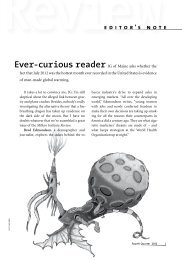The Rise and Fall of the U.S. Mortgage and Credit ... - Milken Institute
The Rise and Fall of the U.S. Mortgage and Credit ... - Milken Institute
The Rise and Fall of the U.S. Mortgage and Credit ... - Milken Institute
You also want an ePaper? Increase the reach of your titles
YUMPU automatically turns print PDFs into web optimized ePapers that Google loves.
On November 24, 2008, a portion <strong>of</strong> $306 billion <strong>of</strong> Citigroup’s assets were guaranteed by <strong>the</strong> government.<br />
Citigroup is set to absorb <strong>the</strong> first loss up to $29 billion, <strong>and</strong> any loss in excess <strong>of</strong> that amount will be shared<br />
by <strong>the</strong> government (90 percent) <strong>and</strong> Citigroup (10 percent). Treasury (via TARP) takes <strong>the</strong> second loss up to $5<br />
billion, while FDIC takes <strong>the</strong> third loss up to $10 billion. <strong>The</strong> Federal Reserve funds <strong>the</strong> remaining pool <strong>of</strong> assets<br />
with a nonrecourse loan, subject to Citigroup’s 10 percent loss sharing, at a floating rate <strong>of</strong> overnight interest<br />
swap plus 300 basis points.<br />
Attracting little notice at <strong>the</strong> time, Treasury issued a new regulation (Notice 2008-83) on September 30, 2008,<br />
allowing banks—<strong>and</strong> only banks—that acquire ano<strong>the</strong>r bank to <strong>of</strong>fset <strong>the</strong>ir pr<strong>of</strong>its with losses from <strong>the</strong> loan<br />
portfolio <strong>of</strong> <strong>the</strong> acquired institution. Since <strong>the</strong> corporate tax rate is essentially 35 percent, this means acquiring<br />
banks can avoid paying $35,000 in taxes for every $100,000 in losses <strong>the</strong>y can use to <strong>of</strong>fset pr<strong>of</strong>its. This created<br />
tremendous incentives for healthier institutions to acquire troubled institutions.<br />
<strong>The</strong> FDIC Takes Steps to Instill Greater Confidence<br />
in Depository Institutions<br />
In response to several high-pr<strong>of</strong>ile bank failures, <strong>the</strong> FDIC took steps to instill greater confidence in all federally<br />
insured depository institutions. On October 3, 2008, <strong>the</strong> EESA temporarily raised <strong>the</strong> basic limit on federal<br />
deposit insurance coverage from $100,000 to $250,000 per depositor (currently <strong>the</strong> basic deposit insurance limit<br />
is scheduled to return to $100,000 after December 31, 2009).<br />
<strong>The</strong> FDIC’s reserves had fallen to $45.2 billion as <strong>of</strong> June 30, 2008, representing 1.01 percent <strong>of</strong> insured domestic<br />
deposits—well below <strong>the</strong> statutory ratio <strong>of</strong> 1.15 percent. To rectify <strong>the</strong> situation, on October 7, 2008, <strong>the</strong> FDIC<br />
adopted a plan to replenish reserves. It also proposed new rules to increase <strong>the</strong> rates banks pay for deposit<br />
insurance, <strong>and</strong> adjusted <strong>the</strong> process by which those rates are set.<br />
On October 14, 2008, Secretary Paulson signed <strong>the</strong> systemic risk exception to <strong>the</strong> FDIC Act, enabling <strong>the</strong> FDIC to<br />
temporarily guarantee <strong>the</strong> senior debt (including promissory notes, commercial paper <strong>and</strong> inter-bank funding)<br />
<strong>of</strong> all FDIC-insured institutions <strong>and</strong> <strong>the</strong>ir holding companies, as well as deposits in non-interest-bearing deposit<br />
transaction accounts. Regulators were to implement an enhanced supervisory framework to assure appropriate<br />
use <strong>of</strong> this new Temporary Liquidity Guarantee Program (TLGP).<br />
<strong>The</strong> FDIC also adopted a mortgage modification program in August 2008 to address foreclosures after it took<br />
over IndyMac Bank (which became IndyMac Federal Bank).<br />
27















